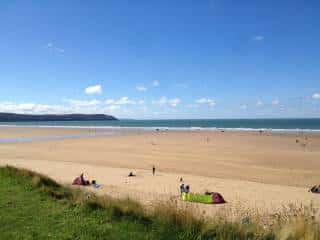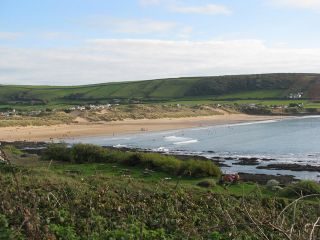
09 Aug OUR TOP 10 DEVON BEACHES
We asked our staff which of Devon’s wonderful beaches was their favourite. Weve listed those below and included a little information about each beach and the surrouding area.. And so here in descending order is our top 10.
Woolacombe Beach
Woolacombe Beach – Award-winning Woolacombe Beach is widely recognised as one of the best beaches in the UK. Located on Devon’s north coast, between Croyde and Ilfracombe, the 3-mile sandy beach is popular with surfers and families looking for a traditional sandy beach.
Woolacombe beach has excellent services including daily cleaning and beach hut rentals. Lifeguards operate on the beach which is popular for kayaking, walking, swimming and kitesurfing as well as surfing. The village of Woolacombe lies at the northern end of the beach, and has plenty of seaside shops, cafes, restaurants and B&B’s.

Bantham Beach
Situated at the mouth of the River Avon, Bantham beach looks out over Bigbury and Burgh Island. Backed by sand dunes and the rolling hills of the South Hams, Bantham has little trouble fitting in with the South Devon Area of Outstanding Natural Beauty.
Bantham is an ideal family beach; a wide expanse of shallow sloping sands, rock pools and plenty of facilities such as the “Gastrobus” serving snacks and drinks, a pub and a cafe. There is also a seasonal lifeguard service making this a safe option.

Blackpool Sands
The crescent-shaped beach of Blackpool Sands is set against an attractive backdrop of pines and the rolling South Hams countryside. The beach itself is something of a misnomer as the sand is in reality mostly a coarse shingle – there is some sand towards the top of the beach though.
There are sandpits for children, while water sports enthusiasts can try kayaking or paddle boarding. Wetsuits and other pieces of equipment are usually available for hire. Those with young children might like to know that the beach shelves quite steeply if you go into the sea, and the waves can be very powerful here. On sunny days, there is often no shade at this beach.

Saunton Sands
Three and a half miles of golden sand backed by one of the most unique and impressive dune systems in the country. Saunton Sands is bounded to the south by the combined estuaries of the rivers Taw and Torridge. Popular with families and longboarders.

Bigbury on Sea Beach
A large, sandy beach, with plenty of facilities, located between the rivers Avon and Erme in South Devon. Safe swimming, rock pools and the intriguing Burgh Island, which can be accessed via a causeway at low tide, or a unique ‘sea tractor’ when the tide is high.

Beer Beach
Sits below the picturesque Devon village of Beer, forming part of the 95-mile Jurassic Coast World Heritage Site. The name “Beer” comes from the Old English translation of “grove”, rather than any connection with the beverage.
The beach here is made up of shingle, and is mostly protected from strong winds and waves because it lies in a cove, protected by the white chalky cliffs of Beer Head.
Visitors will find a small fleet of attractively coloured fishing boats parked by the water’s edge, highlighting that even to this day fishing still plays a part in the economy alongside tourism. In the late afternoon it can be fun to watch the fishing boats bringing in their catches of fish, lobsters and crabs.

Westward Ho! Beach
Facing westwards into Bideford Bay, Surfers and swimmers, kayakers, and paddle boarders will love this long sandy stretch of sand. The main beach is backed by the grassland of Northam Burrows Country Park and the imaginatively named Pebble Ridge.
This part of the coastline is known for its dramatic cliffs, and Westward Ho! is no exception with the beach falling within the North Devon Area of Outstanding Natural Beauty.

Exmouth Beach
Often described as the gateway to the UNESCO World Heritage Jurassic Coach, Exmouth’s two miles of sand are ideal for water sports. This includes boat trips, kayaking, kite surfing, stand-up paddle-boarding, swimming, and windsurfing: it can get extremely busy in the summer. Backed by a wide promenade, it’s also popular all year round with walkers, wildlife enthusiasts, and cyclists, and there are plenty of local restaurants and shops.
Exmouth is perfect for families with classic seaside entertainment such as crazy golf, Dinosaur safari trails, and plenty of food choices. On the promenade, you’ll find old favourites like crazy golf and swing boats. Annual celebrations include Exmouth Festival and the Kite Festival in spring and summer, and seafood festivals later in the year.
The sand is ideal for building sandcastles, picnics, and rock pooling, and there’s also a nearby private beach, Sandy Bay. The beach itself is ideal for walks, or for those who prefer more dramatic options, the cliffs offer dramatic views of the Jurassic Coast.

Croyde Beach
Croyde beach is set in a wide sandy bay between Woolacombe and Saunton Sands beaches. Despite being a little tricky to find and in a rural setting Croyde is one of North Devon’s most popular beaches – and with good reason. Not only is this one of the prettiest spots along the coast it also has the best surf.
Croyde bay sits between two headlands, which offer some protection from the wind. To the rear are sand dunes, and beyond, the rolling green hills of the Devon countryside. Despite being just on the other side of Baggy Point from Woolacombe beach Croyde has a much less developed laid back feel to it.

Sandy Bay
Croyde bay sits between two headlands, which offer some protection from the wind. To the rear are sand dunes, and beyond, the rolling green hills of the Devon countryside. Despite being just on the other side of Baggy Point from Woolacombe beach Croyde has a much less developed laid back feel to it.
In case you hadn’t guessed, Sandy Bay is indeed a very sandy beach! Backed by high cliffs the beach is around a mile in length and set in what feels like a secluded bay. However, towards low tide the beach becomes a continuous stretch of sand reaching all the way to Exmouth nearly two miles away.



